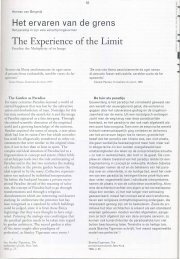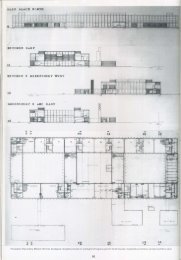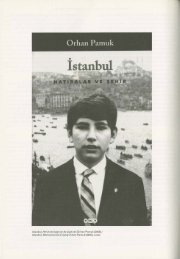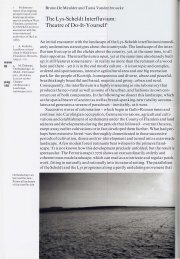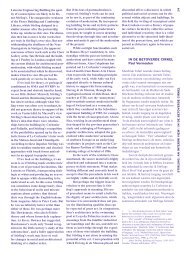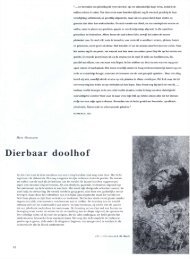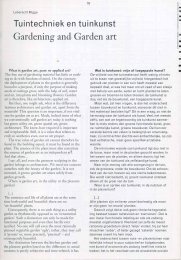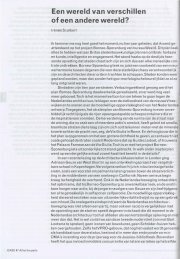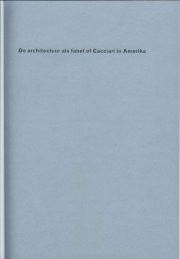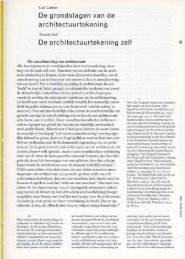OASE_49-50_182.pdf - OASE Journal for Architecture
OASE_49-50_182.pdf - OASE Journal for Architecture
OASE_49-50_182.pdf - OASE Journal for Architecture
Create successful ePaper yourself
Turn your PDF publications into a flip-book with our unique Google optimized e-Paper software.
Epilogue<br />
A conventional building at Zaandam andfive<br />
rhetoric questions to Felix Claus and Kees Kaan<br />
A long time has passed since the winter evening when<br />
a delegation of editors of Oase met Felix Claus and Kees<br />
Kaan at their Amsterdam office. The lively conversation<br />
continued into the late night and offered a remarkable<br />
glimpse behind the screens. The two architects had taken<br />
lhe initiative to organise a series of lectures at the<br />
Amsterdam Academy of <strong>Architecture</strong> titled 'Thicker than<br />
paper' <strong>for</strong> which they had asked architects from various<br />
European countries to talk about their design approach<br />
and the built projects.<br />
<strong>Architecture</strong> thicker than paper, buildings that owe<br />
U1eir strength to an economical use of architectural<br />
gestures, not overtly designed <strong>for</strong> swift consumption.<br />
Soon tile conversation turned to the opportunities and<br />
limitations which the context of building in Holland<br />
imposes on such an approach. By way of illustration<br />
Felix Claus and Kees Kaan discussed one of their then<br />
most recent projects.<br />
The design <strong>for</strong> a large apartment building at<br />
Zaandam, a smallish commuter town north of<br />
Amsterdam, had undergone major changes in the<br />
montils previous to the conversation, be<strong>for</strong>e in an<br />
ultimate attempt at further cutting the costs the design<br />
acquired its definitive <strong>for</strong>m. This development was<br />
remarkable not so much <strong>for</strong> the relentless simplification<br />
produced by tile cuts but <strong>for</strong> the sense of relief which the<br />
architects expressed about it - a liberation which seems<br />
to have affected their work ever since.<br />
Simple volumes and an unequivocal expression of<br />
weight, seriality and anonymity have not been prime<br />
characteristics of postwar Dutch architecture. The tradi<br />
tion of denying weight and a conception of architecture<br />
as assemblage or a composition of abstract planes was<br />
trangely confronted (and possibly confirmed) by Hans<br />
Kallhoff's notorious Piraeus building in Amsterdam, but<br />
continues to exist in an endless array of <strong>for</strong>ms and<br />
emanations.<br />
Paradoxically, it is in the very country which has<br />
achieved a level of standardisation in the building indus<br />
try which is unparallelled in Europe that architects try<br />
their utter best to avoid the standard. The industrial char<br />
acter of tile building process comes disguised by rhetoric<br />
gestures and an inventive application of material. Under<br />
no circumstances is the solution allowed to be self<br />
evident; perhaps, because in these provinces famed <strong>for</strong><br />
their low budgets a building must not be too sober, too<br />
poor, too commonplace; and most certainly not unsenti<br />
mentally hard?<br />
Instead of tile quiet calm which can be achieved<br />
through tile mastery of ordinary <strong>for</strong>ms of construction,<br />
there are often fussy details which communicate noth-<br />
Mechthild Stuhlmacher & Christoph Grafe<br />
183<br />
Epiloog<br />
Een conventioneel gebouw in Zaandam en vijf<br />
retorische vragen aan Felix Claus en Kees Kaan<br />
Het is al geruime tijd geleden. Op een winterse avond ont<br />
moetten enkele Oase-redacteuren Felix Claus en Kees Kaan<br />
op hun bureau in Amsterdam. Het geanimeerde gesprek<br />
duurde tot diep in de nacht en bood een opmerkelijke blik<br />
achter de schermen. Aanleiding voor de afspraak was de<br />
lezingenreeks die de beide architecten aan de Academie<br />
voor Bouwkunst in Amsterdam hadden georganiseerd.<br />
Onder de titel 'T hicker than paper' hadden ze architecten<br />
uit verschillende Europese Ianden uitgenodigd om over<br />
hun standpunten te praten en hun werk te Iaten zien.<br />
Architectuur dikker dan papier, gebouwen die hun<br />
betekenis ontlenen aan een spaarzaam gebruik van<br />
architectonische middelen, niet ontworpen voor de snelle<br />
consumptie. AI snel kwam het gesprek ook op de<br />
mogelijkheden maar ook de beperkingen die het bouwen in<br />
Nederland aan zo'n houding oplegt. Ter verduidelijking hier<br />
van lieten Felix Claus en Kees Kaan een van hun recente<br />
projecten zien.<br />
Het antwerp voor een groot woongebouw in Zaandam<br />
had in de aan het gesprek vooraf gaande maanden al een<br />
groot aantal veranderingen moeten ondergaan, voordat de<br />
laatste- in vele gevallen dodelijke- bezuinigingsronde de<br />
vorm bepaalde die uiteindelijk gebouwd zou worden. Het<br />
opmerkelijke hieraan waren niet de onbarmhartige vereen<br />
voudigingen door de bezuinigingen, maar het gevoel van<br />
bevrijding dat deze kaalslag bij de architecten teweeg had<br />
gebracht- en zeker ook hun latere ontwerpen heeft<br />
be"lnvloed.<br />
Eenvoudige bouwmassa's en een onverholen expressie<br />
van zwaarte, seriematigheid en anonimiteit zijn ontwerp<br />
aspecten die niet of nauwelijks in het repertoire van de<br />
recente Nederlandse architectuur voorkomen. De traditie<br />
van gewichtloosheid en het denken in vlakken in plaats van<br />
in massa's werd weliswaar door het controversiele gebouw<br />
'Piraeus' van Hans Kallhoff in Amsterdam op een merk<br />
waardige manier met zichzelf geconfronteerd (misschien<br />
zelfs bevestigd), maar leeft onverminderd en in oneindig<br />
veel vormen en gedaanten voort.<br />
In het land met de me est gestandaardiseerde bouw<br />
industrie in Europa doen architecten hun uiterste best om<br />
de standaard te ontwijken. Het industriele karakter van het<br />
bouwproces wordt verhuld in retorische gebaren of inventief<br />
materiaalgebruik. De oplossing mag niet voor de hand<br />
liggen. Misschien omdat in het land met de laagste bouw<br />
prijzen een gebouw vooral niet te sober, te arm, te gewoon<br />
mag zijn? En zeker niet te onsentimenteel hard?<br />
In plaats van de vanzelfsprekende kalmte die uit de<br />
beheersing van het gangbare kan voortkomen, zien we<br />
opgedirkte 'details', die niets vertellen- niet over hoe het<br />
gebouw gemaakt is, niet over hoe het zich verhoudt tot zijn<br />
fysieke en mentale context, niet over de normen en<br />
<strong>OASE</strong> # <strong>49</strong>/<strong>50</strong> 1998




